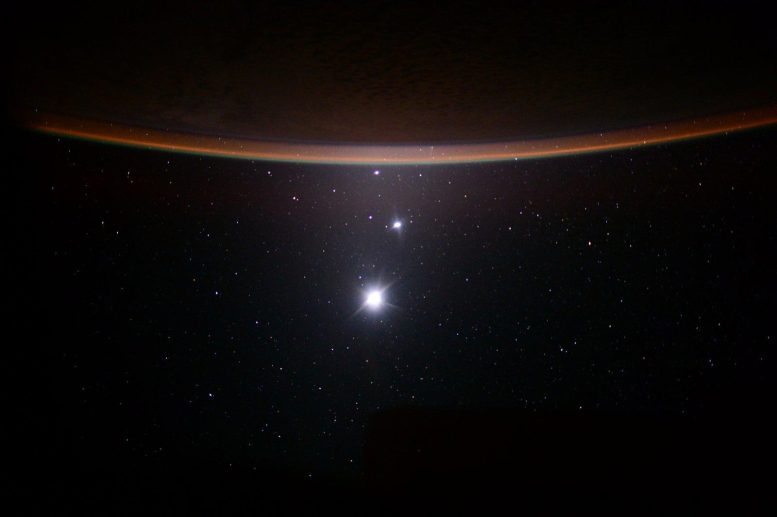
L’astronauta Scott Kelly osserva tre pianeti e la luna terrestre in uno spettacolo impressionante mentre conduce ricerche per un volo spaziale di lunga durata a bordo della Stazione Spaziale Internazionale. L’immagine mostra la Luna terrestre, Venere, Giove e la mezzaluna terrestre, disposte dal basso verso l’alto. Credito: NASA/Scott Kelly
La seconda metà di maggio offre grandi opportunità per osservare le stelle. Il 17 maggio[{” attribute=””>Jupiter and a crescent moon will be visible together before sunrise. From May 22 to 24, the Moon, Venus, and Mars will form a close grouping in the western sky after sunset. Stargazers in the Southern Hemisphere will experience distinct differences, and the large and small Magellanic Clouds can be observed with the naked eye.
May is a great month for stargazing with a host of celestial events happening in the morning and evening skies.
On May 17, a slim crescent moon will rise about an hour before the Sun. From much of the United States and Canada, you’ll be able to see Jupiter appearing very close to the Moon. In some southern U.S. states, Jupiter will pass behind the Moon as the pair rises in morning twilight. From western states, Jupiter will be behind the Moon, in occultation, as the duo rise. Jupiter will start to emerge from behind the Moon as the Sun comes up. To observe this event, you’ll need a clear view of the horizon, and a pair of binoculars will be essential as many locations in the U.S. will be in daylight during this occultation.

Some celestial objects are only visible from Earth’s Southern Hemisphere, such as central portions of our Milky Way galaxy, left, plus the two Magellanic Clouds above and to the left of the observatory dome, as shown in this photo taken at Cerro Paranal in Chile’s Atacama Desert. Credit: ESO/Y. Beletsky
Following sunset from May 22 through 24, you’ll be able to witness a close grouping of the Moon, Venus, and Mars in the western sky. The Moon will sit between the two planets on the 23rd. Venus has been rising higher in the sky each evening for the past few months, but in May, it’ll reach its highest point in the western sky.
For those stargazing from the Southern Hemisphere, there are some key differences in the night sky compared to the Northern Hemisphere. For instance, there’s no counterpart to the North Star in the Southern Hemisphere, and the seasonal star patterns that a northern observer are familiar with appear flipped upside down when viewed in southern skies.
Two entire galaxies, the large and small Magellanic Clouds, can be easily observed in the southern sky with the unaided eye. These are dwarf galaxies that orbit our own Milky Way galaxy.
If you are interested in what else is in the sky for May, check out the latest “What’s Up” video from Jet Propulsion Laboratory:
Quali sono alcuni dei punti salienti dello skywatching nel maggio 2023? Venere raggiunge il suo punto più alto nel cielo serale per quest’anno, mentre Giove si nasconde dietro la luna per alcuni osservatori americani. Inoltre alcune importanti differenze nel cielo dell’emisfero australe rispetto al cielo settentrionale.

“Fan della TV. Risolutore di problemi malvagi. Amante del cibo appassionato. Explorer. Specialista di Internet. Imprenditore dilettante. Fanatico dell’alcol.”




